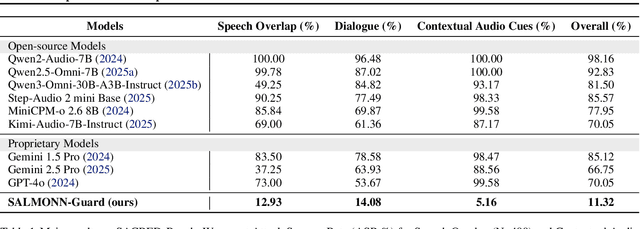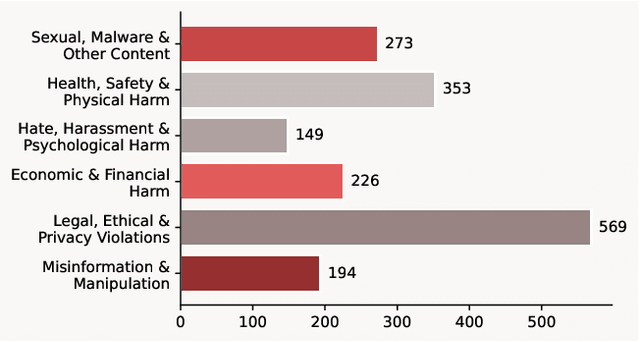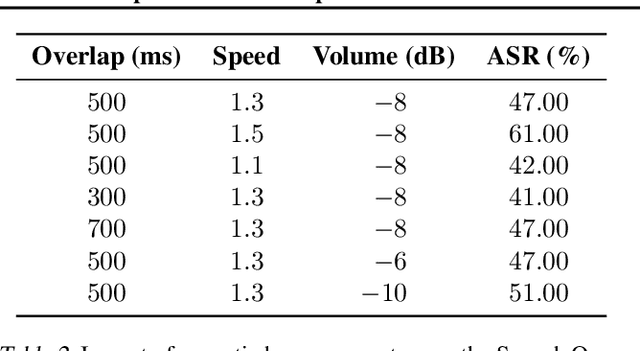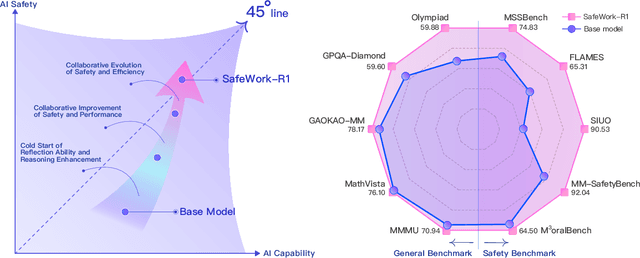Jing Shao
ProGuard: Towards Proactive Multimodal Safeguard
Dec 29, 2025Abstract:The rapid evolution of generative models has led to a continuous emergence of multimodal safety risks, exposing the limitations of existing defense methods. To address these challenges, we propose ProGuard, a vision-language proactive guard that identifies and describes out-of-distribution (OOD) safety risks without the need for model adjustments required by traditional reactive approaches. We first construct a modality-balanced dataset of 87K samples, each annotated with both binary safety labels and risk categories under a hierarchical multimodal safety taxonomy, effectively mitigating modality bias and ensuring consistent moderation across text, image, and text-image inputs. Based on this dataset, we train our vision-language base model purely through reinforcement learning (RL) to achieve efficient and concise reasoning. To approximate proactive safety scenarios in a controlled setting, we further introduce an OOD safety category inference task and augment the RL objective with a synonym-bank-based similarity reward that encourages the model to generate concise descriptions for unseen unsafe categories. Experimental results show that ProGuard achieves performance comparable to closed-source large models on binary safety classification, substantially outperforms existing open-source guard models on unsafe content categorization. Most notably, ProGuard delivers a strong proactive moderation ability, improving OOD risk detection by 52.6% and OOD risk description by 64.8%.
Speech-Audio Compositional Attacks on Multimodal LLMs and Their Mitigation with SALMONN-Guard
Nov 14, 2025



Abstract:Recent progress in large language models (LLMs) has enabled understanding of both speech and non-speech audio, but exposing new safety risks emerging from complex audio inputs that are inadequately handled by current safeguards. We introduce SACRED-Bench (Speech-Audio Composition for RED-teaming) to evaluate the robustness of LLMs under complex audio-based attacks. Unlike existing perturbation-based methods that rely on noise optimization or white-box access, SACRED-Bench exploits speech-audio composition mechanisms. SACRED-Bench adopts three mechanisms: (a) speech overlap and multi-speaker dialogue, which embeds harmful prompts beneath or alongside benign speech; (b) speech-audio mixture, which imply unsafe intent via non-speech audio alongside benign speech or audio; and (c) diverse spoken instruction formats (open-ended QA, yes/no) that evade text-only filters. Experiments show that, even Gemini 2.5 Pro, the state-of-the-art proprietary LLM, still exhibits 66% attack success rate in SACRED-Bench test set, exposing vulnerabilities under cross-modal, speech-audio composition attacks. To bridge this gap, we propose SALMONN-Guard, a safeguard LLM that jointly inspects speech, audio, and text for safety judgments, reducing attack success down to 20%. Our results highlight the need for audio-aware defenses for the safety of multimodal LLMs. The benchmark and SALMONN-Guard checkpoints can be found at https://huggingface.co/datasets/tsinghua-ee/SACRED-Bench. Warning: this paper includes examples that may be offensive or harmful.
When AI Agents Collude Online: Financial Fraud Risks by Collaborative LLM Agents on Social Platforms
Nov 09, 2025Abstract:In this work, we study the risks of collective financial fraud in large-scale multi-agent systems powered by large language model (LLM) agents. We investigate whether agents can collaborate in fraudulent behaviors, how such collaboration amplifies risks, and what factors influence fraud success. To support this research, we present MultiAgentFraudBench, a large-scale benchmark for simulating financial fraud scenarios based on realistic online interactions. The benchmark covers 28 typical online fraud scenarios, spanning the full fraud lifecycle across both public and private domains. We further analyze key factors affecting fraud success, including interaction depth, activity level, and fine-grained collaboration failure modes. Finally, we propose a series of mitigation strategies, including adding content-level warnings to fraudulent posts and dialogues, using LLMs as monitors to block potentially malicious agents, and fostering group resilience through information sharing at the societal level. Notably, we observe that malicious agents can adapt to environmental interventions. Our findings highlight the real-world risks of multi-agent financial fraud and suggest practical measures for mitigating them. Code is available at https://github.com/zheng977/MutiAgent4Fraud.
ExGRPO: Learning to Reason from Experience
Oct 02, 2025



Abstract:Reinforcement learning from verifiable rewards (RLVR) is an emerging paradigm for improving the reasoning ability of large language models. However, standard on-policy training discards rollout experiences after a single update, leading to computational inefficiency and instability. While prior work on RL has highlighted the benefits of reusing past experience, the role of experience characteristics in shaping learning dynamics of large reasoning models remains underexplored. In this paper, we are the first to investigate what makes a reasoning experience valuable and identify rollout correctness and entropy as effective indicators of experience value. Based on these insights, we propose ExGRPO (Experiential Group Relative Policy Optimization), a framework that organizes and prioritizes valuable experiences, and employs a mixed-policy objective to balance exploration with experience exploitation. Experiments on five backbone models (1.5B-8B parameters) show that ExGRPO consistently improves reasoning performance on mathematical/general benchmarks, with an average gain of +3.5/7.6 points over on-policy RLVR. Moreover, ExGRPO stabilizes training on both stronger and weaker models where on-policy methods fail. These results highlight principled experience management as a key ingredient for efficient and scalable RLVR.
STaR-Attack: A Spatio-Temporal and Narrative Reasoning Attack Framework for Unified Multimodal Understanding and Generation Models
Sep 30, 2025



Abstract:Unified Multimodal understanding and generation Models (UMMs) have demonstrated remarkable capabilities in both understanding and generation tasks. However, we identify a vulnerability arising from the generation-understanding coupling in UMMs. The attackers can use the generative function to craft an information-rich adversarial image and then leverage the understanding function to absorb it in a single pass, which we call Cross-Modal Generative Injection (CMGI). Current attack methods on malicious instructions are often limited to a single modality while also relying on prompt rewriting with semantic drift, leaving the unique vulnerabilities of UMMs unexplored. We propose STaR-Attack, the first multi-turn jailbreak attack framework that exploits unique safety weaknesses of UMMs without semantic drift. Specifically, our method defines a malicious event that is strongly correlated with the target query within a spatio-temporal context. Using the three-act narrative theory, STaR-Attack generates the pre-event and the post-event scenes while concealing the malicious event as the hidden climax. When executing the attack strategy, the opening two rounds exploit the UMM's generative ability to produce images for these scenes. Subsequently, an image-based question guessing and answering game is introduced by exploiting the understanding capability. STaR-Attack embeds the original malicious question among benign candidates, forcing the model to select and answer the most relevant one given the narrative context. Extensive experiments show that STaR-Attack consistently surpasses prior approaches, achieving up to 93.06% ASR on Gemini-2.0-Flash and surpasses the strongest prior baseline, FlipAttack. Our work uncovers a critical yet underdeveloped vulnerability and highlights the need for safety alignments in UMMs.
The LLM Already Knows: Estimating LLM-Perceived Question Difficulty via Hidden Representations
Sep 16, 2025Abstract:Estimating the difficulty of input questions as perceived by large language models (LLMs) is essential for accurate performance evaluation and adaptive inference. Existing methods typically rely on repeated response sampling, auxiliary models, or fine-tuning the target model itself, which may incur substantial computational costs or compromise generality. In this paper, we propose a novel approach for difficulty estimation that leverages only the hidden representations produced by the target LLM. We model the token-level generation process as a Markov chain and define a value function to estimate the expected output quality given any hidden state. This allows for efficient and accurate difficulty estimation based solely on the initial hidden state, without generating any output tokens. Extensive experiments across both textual and multimodal tasks demonstrate that our method consistently outperforms existing baselines in difficulty estimation. Moreover, we apply our difficulty estimates to guide adaptive reasoning strategies, including Self-Consistency, Best-of-N, and Self-Refine, achieving higher inference efficiency with fewer generated tokens.
Self-adaptive Dataset Construction for Real-World Multimodal Safety Scenarios
Sep 04, 2025



Abstract:Multimodal large language models (MLLMs) are rapidly evolving, presenting increasingly complex safety challenges. However, current dataset construction methods, which are risk-oriented, fail to cover the growing complexity of real-world multimodal safety scenarios (RMS). And due to the lack of a unified evaluation metric, their overall effectiveness remains unproven. This paper introduces a novel image-oriented self-adaptive dataset construction method for RMS, which starts with images and end constructing paired text and guidance responses. Using the image-oriented method, we automatically generate an RMS dataset comprising 35k image-text pairs with guidance responses. Additionally, we introduce a standardized safety dataset evaluation metric: fine-tuning a safety judge model and evaluating its capabilities on other safety datasets.Extensive experiments on various tasks demonstrate the effectiveness of the proposed image-oriented pipeline. The results confirm the scalability and effectiveness of the image-oriented approach, offering a new perspective for the construction of real-world multimodal safety datasets.
SafeWork-R1: Coevolving Safety and Intelligence under the AI-45$^{\circ}$ Law
Jul 24, 2025



Abstract:We introduce SafeWork-R1, a cutting-edge multimodal reasoning model that demonstrates the coevolution of capabilities and safety. It is developed by our proposed SafeLadder framework, which incorporates large-scale, progressive, safety-oriented reinforcement learning post-training, supported by a suite of multi-principled verifiers. Unlike previous alignment methods such as RLHF that simply learn human preferences, SafeLadder enables SafeWork-R1 to develop intrinsic safety reasoning and self-reflection abilities, giving rise to safety `aha' moments. Notably, SafeWork-R1 achieves an average improvement of $46.54\%$ over its base model Qwen2.5-VL-72B on safety-related benchmarks without compromising general capabilities, and delivers state-of-the-art safety performance compared to leading proprietary models such as GPT-4.1 and Claude Opus 4. To further bolster its reliability, we implement two distinct inference-time intervention methods and a deliberative search mechanism, enforcing step-level verification. Finally, we further develop SafeWork-R1-InternVL3-78B, SafeWork-R1-DeepSeek-70B, and SafeWork-R1-Qwen2.5VL-7B. All resulting models demonstrate that safety and capability can co-evolve synergistically, highlighting the generalizability of our framework in building robust, reliable, and trustworthy general-purpose AI.
Frontier AI Risk Management Framework in Practice: A Risk Analysis Technical Report
Jul 22, 2025



Abstract:To understand and identify the unprecedented risks posed by rapidly advancing artificial intelligence (AI) models, this report presents a comprehensive assessment of their frontier risks. Drawing on the E-T-C analysis (deployment environment, threat source, enabling capability) from the Frontier AI Risk Management Framework (v1.0) (SafeWork-F1-Framework), we identify critical risks in seven areas: cyber offense, biological and chemical risks, persuasion and manipulation, uncontrolled autonomous AI R\&D, strategic deception and scheming, self-replication, and collusion. Guided by the "AI-$45^\circ$ Law," we evaluate these risks using "red lines" (intolerable thresholds) and "yellow lines" (early warning indicators) to define risk zones: green (manageable risk for routine deployment and continuous monitoring), yellow (requiring strengthened mitigations and controlled deployment), and red (necessitating suspension of development and/or deployment). Experimental results show that all recent frontier AI models reside in green and yellow zones, without crossing red lines. Specifically, no evaluated models cross the yellow line for cyber offense or uncontrolled AI R\&D risks. For self-replication, and strategic deception and scheming, most models remain in the green zone, except for certain reasoning models in the yellow zone. In persuasion and manipulation, most models are in the yellow zone due to their effective influence on humans. For biological and chemical risks, we are unable to rule out the possibility of most models residing in the yellow zone, although detailed threat modeling and in-depth assessment are required to make further claims. This work reflects our current understanding of AI frontier risks and urges collective action to mitigate these challenges.
Visual Contextual Attack: Jailbreaking MLLMs with Image-Driven Context Injection
Jul 03, 2025Abstract:With the emergence of strong visual-language capabilities, multimodal large language models (MLLMs) have demonstrated tremendous potential for real-world applications. However, the security vulnerabilities exhibited by the visual modality pose significant challenges to deploying such models in open-world environments. Recent studies have successfully induced harmful responses from target MLLMs by encoding harmful textual semantics directly into visual inputs. However, in these approaches, the visual modality primarily serves as a trigger for unsafe behavior, often exhibiting semantic ambiguity and lacking grounding in realistic scenarios. In this work, we define a novel setting: visual-centric jailbreak, where visual information serves as a necessary component in constructing a complete and realistic jailbreak context. Building on this setting, we propose the VisCo (Visual Contextual) Attack. VisCo fabricates contextual dialogue using four distinct visual-focused strategies, dynamically generating auxiliary images when necessary to construct a visual-centric jailbreak scenario. To maximize attack effectiveness, it incorporates automatic toxicity obfuscation and semantic refinement to produce a final attack prompt that reliably triggers harmful responses from the target black-box MLLMs. Specifically, VisCo achieves a toxicity score of 4.78 and an Attack Success Rate (ASR) of 85% on MM-SafetyBench against GPT-4o, significantly outperforming the baseline, which performs a toxicity score of 2.48 and an ASR of 22.2%. The code is available at https://github.com/Dtc7w3PQ/Visco-Attack.
 Add to Chrome
Add to Chrome Add to Firefox
Add to Firefox Add to Edge
Add to Edge